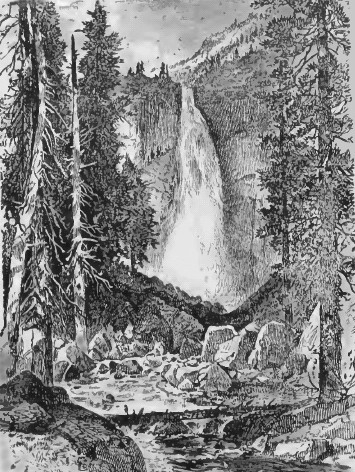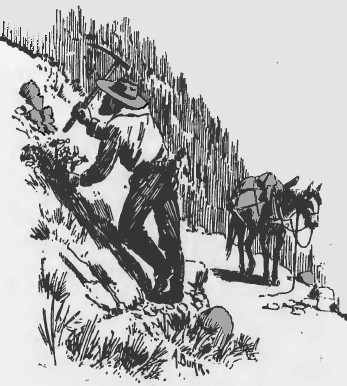California has been the source of more than 106 million troy ounces of gold, the Second most productive state in the Union (Although Nevada has surpassed California in recent years). However, production has greatly declined in recent years because of high costs and depletion of easily accessible deposits. Although gold was mined in California in the late 18th and early 19th Centuries, the gold rush did not begin until after Marshall's discovery at Sutter's Mill in 1848. Thousands of gold seekers soon arrived, and in a few years much of the state was permanently settled. Gold production attained an all-time high of $81 million in 1852 but then declined because of the exhaustion of the rich surface placers. At the last government-set price of $35 per ounce, the 1852 amount would have been about $138 million. Hydraulic mines became the largest sources of gold until curtailed by court order in 1884. Lode mines and dredges were the principal sources after that date. During the depression years of the 1930s, gold output in the state was nearly as high as it had been during the gold rush. Gold mining was curtailed during World War II end has not recovered since. A number of spectacular nuggets and masses of pure gold were recovered in California during the early days. The most famous were the 195-pound mass of gold from Carson Hill and the 54-pound Willard nugget from Magalia. Small high-grade ore shoots or pockets have been found in many districts, but the richest and most numerous have been in the Alleghany district of Sierra County.
Although gold is found in many areas in California, the most productive districts are in the northern and central portions of the Sierra Nevada. The primary deposits usually consist of gold-quartz veins in metamorphic rocks and are associated with the intrusion of the Sierra Nevada batholith. The most productive lode-gold districts in the Sierra Nevada have been the Grass Valley, Nevada City, Alleghany, and Sierra City districts, those of the Mother Lode belt, and several in the so-called East and West Gold Belts. Several districts are in the southern end of the range. The Sierra Nevada placer deposits are divisible into the older or Tertiary deposits, which were mined by hydraulicking and drifting, and the younger or Quaternary stream deposits, which have been mined by dredging. The principal Tertiary deposits are in the La Porte, Poker Flat, Magalia, Cherokee, North Bloomfield, North Columbia, Dutch Flat, Damascus, Forest Hill, Iowa Hill, Mokelumne Hill, and Columbia districts. The largest dredging fields were at Hammonton, Folsom, Oroville, Comanche, La Grange, and Snelling.
In the Klamath Mountain, the second most-productive province, the largest sources of gold have been the streams of the Klamath-Trinity River system. The older terrace deposits along the sides of the present stream channels also have yielded much gold and were mined by hydraulicking. The most productive source of lode-gold has been the French Gulch district of Shasta and Trinity Counties. Other important lode-mining centers were the Harrison Gulch, Liberty, Callahan, Sawyers Bar, Weaverville, and Old Diggings districts. The Basin Ranges and Mojave Desert provinces of eastern and southern California have yielded substantial amounts of gold. The gold occurs either in epithermal deposits in brecciated silicified zones of Tertiary volcanic rocks or in mesothermal quartz veins of older metamorphic and granitic rocks. Gold also has been recovered from dry placers in several districts. The Bodie district has been the most important gold source in the Basin Ranges, while the Mojave, Rand, Stedman, and Cargo Muchacho districts contain the most productive mines in the Mojave Desert.
Moderate amounts of gold have been mined in the Transverse and Peninsular Ranges in southern California, the principal sources having been the Frazier Mountain, Saugus, Acton, Pinacote, Julian-Banner, and Cuyamaco districts. The mineral also has been recovered from the Modoc Plateau province in northeastern California, the main source having been the Hoyden Hill district. Small amounts of gold have been produced in a number of places in the Coast Ranges.Between 1848 and 1967, California was the source of more than 106 million troy ounces of gold. This total was far greater than that for any other state in the Union and represented about 35 percent of the total United States production. California's gold mining has been important in the history and development of the western United States. The influence it has had on the development and perfection of mining and metallurgical processes also has been significant. Although world gold production has gradually increased in recent years, chiefly because of increased output in the Union of South Africa and the Soviet Union, United States production, particularly that in California, has diminished. This diminishing trend is attributable to increased costs for labor and supplies combined with, until recently, a fixed price for domestically mined gold ($35 per fine ounce at the time of this writing), the expense of reconditioning mines shut down during World War II, and depletion of many gold deposits. Another factor in California is the increased real estate value of many gold-bearing properties. In addition, a number of gold mines and gold-bearing deposits have been inundated by reservoirs.
The word "district" as used in this article denotes an area or zone of natural gold mineralization. The location and extent of these districts are determined by the occurrence of deposits that have yielded gold in commercial amounts. Often the limits of the individual districts are not well defined, because the boundaries between rocks that have yielded commercial ore and those that have not are indefinite. Except in portions of the desert regions, the limits of the named mining districts in California often are uncertain. Commonly, what has been referred to as an organized mining district actually has been nothing more than a center of mining operations with an appropriate geographic name.
The size and productivity of the gold districts of California vary widely. Some are scores of square miles in extent and others cover only a few square miles. However, size often is no indication of the richness of the deposits or of the total value of output. Some lode gold districts, such as Grass Valley, Alleghany, and Randsburg, contain many rich veins in a small area. Some placer-gold districts contain channel deposits of several different ages, and others contain deposits only of one age. Some districts are mostly lode, some mostly placer, and others have both lode and placer deposits. In the Sierra Nevada and Klamath Mountains, the gold mineralization is extensive. However, studies show that the bulk of the gold production has come from distinct districts within these major regions.
The organized mining districts were important during the days of the frontier. These were organized by the miners themselves to establish law and order. The miners would meet to draft bylaws defining the size of claims and territorial jurisdiction of the district Commonly these laws included procedures for the punishment of claim jumpers, sluice robbers, and murderers. A recorder was appointed to keep records. The customs and laws were derived chiefly from European mining districts. The importance of the organized mining districts diminished after the Federal Mining Acts of 1866 and 1872. The official records of some of the old districts still exist and are on file in county recorders' offices. California's gold-mining history is a brilliant lure, and many books, pamphlets, periodicals and articles have been published on the subject. The old mining districts and settlements, including "ghost" towns, are visited by increasing numbers of tourists each year. In a few districts the old camps have been reconstructed. Several old gold mining towns, such as Columbia, Johnsville, Coloma, Shasta, and Bodie, are California state parks or recreation areas. In recent years more people have become aware of the importance of California's gold rush in the history and development of the western United States, and steps have been made to preserve historical structures and equipment closely associated with gold mining.
Unfortunately, little visible evidence remains of many of California's important gold-quartz mines other than caved shafts and tunnels and heavily overgrown dumps. The surface plants of the large underground lode mines at Grass Valley and along the Mother Lode belt, which for years accounted for a major part of California's gold output, have been almost completely dismantled. More evidence remains of the large-scale placer-mining operations. The old hydraulic mine pits and the extensive tailing piles in the dredging fields still exist; some are used as commercial sources of sand and gravel. A number of the old ditches, flumes, and reservoirs that once supplied water to the hydraulic mines now are parts of hydroelectric and irrigation systems.
Continue on to:
Gold Gravels Of California
Return To:
Important Gold Mining Regions Worldwide


